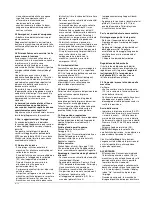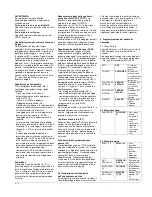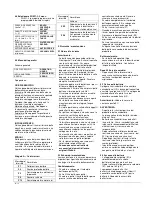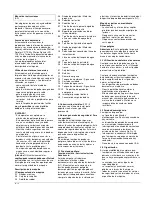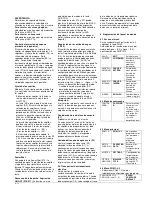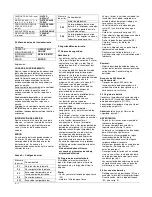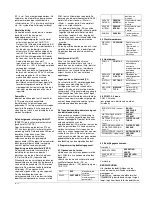
32 / 74
(forwards or backwards) (see the
Lowering the brushes
section).
-
If the machine remains in one spot for
approx. 2 seconds, the brush housing
(A2) automatically rises to the stand-by
position, and the brushes cease rotating.
The LED for button P8 will blink while the
stand-by position is maintained. Only
when the machine begins to move again
(forwards or backwards) will the brushes
leave the stand-by position to resume
their activity and the brush housing (A2)
redescend into the working position (see
the
Lowering the brushes
section).
-
If the brush motor experiences an
overload, the application pressure is
automatically corrected by raising the
brush lift motor. If the correction is
unsuccessful, the brush motor will stop at
the same time that it rises to the park
position. F20 will appear on the display.
-
For indirect work, suction can be turned
off with the P10 button (full suction) or
P11 button (reduced suction). The
appropriate LED will blink.
-
Brush pressure (P2/P3) and water
quantity (P4/P5) can be readjusted with
the push buttons according to the level of
soiling. When the machine is turned off
completely with the main key switch (G2),
water quantity and brush pressure return
to their default settings.
Parking or emergency brake
If an obstacle is suddenly encountered, the
machine can be brought abruptly to a stop
by activating the brake pedal (A6), by
pulling the emergency stop connector
(G1/H1), or by turning the main key switch
(G2) to “OFF” (see Fig. G and H).
The brake is released again once the
accelerator pedal has been activated, the
battery charge / emergency stop connector
is plugged in, the main key switch is set to
“ON,” and the seat switch is closed.
Working method
-
Choose the longest runs possible and
avoid sharp curves.
-
When working in lanes, overlap the edge
of the surface just cleaned by approx. 3 to
5 cm on the next pass.
-
Adjust water dosage and travel speed to
the floor’s level of soiling. Use the
smallest quantity of water possible, and
work with the
power shot
function as
needed.
-
Heavily soiled floors should be well
wetted first with a cleaning solution (even
before a thorough cleaning) and the
solution should be allowed to work for
several minutes (indirect working
method). The suction motor button (P10)
must be activated, after the GO/STOP
button has been activated, to turn off
suction. Then, with rotating brushes,
vacuum with an empty tank or with the
water dosage set to the minimum
position. With the Sprinter XR70/90
TwinTurbo, the suction level can be set to
“reduced” or “maximum” according to
need. Please note that electric power
consumption is higher for maximum
suction power.
Warning!
Travel on a gradient
When moving along a descending surface,
the speed of the machine can be regulated
by means of the accelerator pedal (A5).
The motor brake is applied automatically on
steep gradients and can be assisted further
with the brake pedal. The machine must
not travel on slopes or gradients greater
than 8%. For
safety reasons
, Wetrok
requires
reduced speed
(P15) on
gradients
. Turns on gradients should be
negotiated especially carefully and slowly.
Battery discharge monitor (P1)
Fully charged (battery level 3)
Approx. half charged (battery
level 2)
The brushes are raised and the
water turned off; vacuuming
can continue for approx. 5
minutes. Batteries must then
be recharged (to battery level
1)
Vacuum cleaner stops, suction
nozzle rises, travel to the
charging station possible.
Charge battery. (Battery level
0)
F2
Travel stops (deep discharge).
Warning! Charge immediately
to avoid the risk of damage.
Tip: If required, the parameter settings can
be used to enable an audible warning
signal for any given charge level.
NOTE:
As soon as the
symbol appears, the brushes
are raised and the water is turned off.
After that, the “brush motor” and “suction
motor” functions can no longer be turned on
until the battery is charged.
The drive motor and the controls, including
the display (P1), will continue to function as
long as technically possible, but only until
the lower voltage limit of
≤
17 V is reached.
Below this value, the controls immediately
switch off completely.
Traction control
The travel direction is entered by means of
the operating panel (P6/P7). For travel in
reverse, traction power is automatically
reduced to approx. 50%. When reverse
travel occurs, a warning signal sounds,
unless it is disabled manually. At the same
time, two other buttons (P14/P15) can be
used to regulate speed in both travel
directions. Smooth starts are simplified by
means of the ASD function (P18), which
allows the machine to accelerate slowly
and evenly with the pedal fully depressed.
Maximum travel speed: (LED P14 lights
up)
Restriction when making turns without a
reduction in speed (full speed). To prevent
instability (tipping) when turns are taken at
excessive speed, there is a built-in
automatic limitation of the maximum steer
angle. The steer angle limitation begins at
an angle of +/- 10° away from travel in a
straight direction.
Reduced travel speed: (LED P15 lights
up)
This is to be preferred as the standard
setting. It allows unrestricted
manoeuvrability of the machine on curves
at reduced speed (approx. half speed).
NOTE:
For safety reasons, Wetrok recommends
that speed be adjusted to the situation.
For travel on curves and gradients:
Travel speed at the reduced setting. LED
P15 lights up.
For travel in a straight line:
Travel speed at the maximum setting. LED
P14 lights up.
Foam formation monitor (symbol on the
display)
The water feed and the brush motor turn off
after about 10 seconds, and the brush
housing (A2) returns to its parking position.
Seven seconds later, the suction unit (B2)
is raised. Following a delay set to the
customer’s preference (factory setting: 15
seconds), the suction motor shuts off. The
recovery tank (F2) is full and must be
emptied. The suction and brush motors and
the pump cannot be turned back on until
the foam sensors (F1) are no longer
activated, at which point the symbol
disappears from the display.
Adjusting the brushes
Three buttons on the operating panel (Fig.
1) control the main brush functions.
-
Brush lifting motion (this function is
started automatically by means of the
GO/STOP button)
The button (P8) raises or lowers the
brush housing (A2). The water feed and
brush rotation start automatically. The
LED for the keys blinks during lifting until
the upper limit position has been reached.
The button for lowering is ignored while
the LED is blinking.
-
The brush application pressure can be
increased or decreased in 5 increments
by means of two command buttons,
“Brush pr” (P2) or “Brush
pressure -” (P3).


